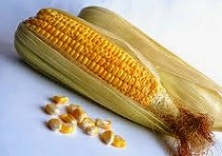 The notion of corn , coming from the Taíno mahís , refers to a plant that is part of the family group of grasses . It can reach a height of up to three meters, with a very thick stem, pointed leaves and female and male flowers.
The notion of corn , coming from the Taíno mahís , refers to a plant that is part of the family group of grasses . It can reach a height of up to three meters, with a very thick stem, pointed leaves and female and male flowers.
Corn is native to the American continent, where it was domesticated about 10,000 years ago. It arrived in Europe in the 17th century . Currently it is one of the most important crops in the world due to its nutritional relevance, since it produces ears whose grains are highly valued.
The fruit of certain grass plants, which grows in a dense spike and has grains that are located side by side, is called cob . In the case of corn, these grains are yellow. It should be noted that the term corn is also used to refer specifically to the cob (or corn ) and the grains.
There are multiple varieties of corn. The Mayans and Olmecs already cultivated several of them, preparing the grains in different ways. Starting in 2500 BC, crops expanded throughout the American territory and, after the arrival of the European conquerors, they ended up arriving in the Old Continent .
As food , corn is used in numerous ways. It is possible to boil the whole cob to eat the kernels, or cook the shelled corn to use in soups, salads, stews, etc. Corn oil , meanwhile, is used for frying, while corn flour can be eaten directly or used as an ingredient in other recipes.
Fried corn , corn flakes , popcorn ( corn rosettes , pochoclo , pororó or popcorn ), humita , tamales , polenta , tortillas , locro , Paraguayan soup , tacos and arepas are other products prepared with corn.
Evidently, many ancient cultures knew the properties of corn since they used it as one of the basic foods in their diet . Currently it continues to be among the most popular, not only for its benefits for our health but also for its aforementioned versatility.
First of all, we can say that its content is very rich in vitamins A, B and E , and also in minerals, such as potassium, phosphorus, sodium and magnesium . The latter are essential for neuromuscular functioning and for hydroelectrolyte balance, two reasons why athletes have it among their most important foods. Hypertension and diabetes, among other diseases , can be combated by eating corn.
 Another characteristic of corn is that it contains a good proportion of antioxidants , necessary to prevent the emergence of free radicals and, therefore, cancer-causing diseases. More than one case of prostate and breast cancer has been successfully combated thanks to the use of this food, whose antioxidant properties are enhanced when cooked.
Another characteristic of corn is that it contains a good proportion of antioxidants , necessary to prevent the emergence of free radicals and, therefore, cancer-causing diseases. More than one case of prostate and breast cancer has been successfully combated thanks to the use of this food, whose antioxidant properties are enhanced when cooked.
Richness in vitamins is necessary for the development of the nervous system, both in childhood and in adulthood. Of the three mentioned above, vitamin A is the most present in corn; Among its benefits are those related to vision and skin , in addition to those obtained by pregnant women so that their babies grow healthier .
Corn is also rich in protein : just one cup of this product is enough to consume the 9 percent of recommended protein per day. On the other hand, it does not include all the amino acids that our body needs, and that is why it is advisable to supplement it with beans.
Regarding fiber , corn also contains it in an important proportion. The regulation of digestion, glucose and cholesterol levels are three benefits that it can bring us, with the addition of reducing the risk of cardiovascular diseases.
